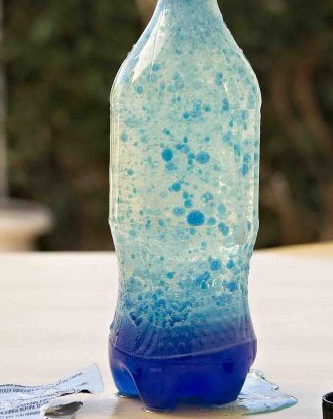





Published on Sep 16, 2023
The objective: To explore the relationship between oil and water in terms of density as well as hydrophilic/hydrophobic compounds.
To observe a chemical reaction between an acid and a base.
1. What happens when you add water to the plastic bottle? Why do you think this occurs?
2. What happens when you add the food coloring to the bottle? Why do you think this occurs?
3. What happens when you add the Alka-Seltz er to the bottle? Why do you think this occurs?
4 . What experiments did you perform on the closed soda bottle (twisting, shaking, etc.)? What did you notice during each trial?
Oil and water mixture – Oil, a hydrophobic compound, and water, a hydrophilic compound, do not mix. See detailed discussion in Introduction section. Acid-base reaction – A chemical reaction between two substances where one is an acid and one is a base. Hydrophobic compound – A ‘scared of water’ compound that do not dissolve easily in water. Hydrophilic compound – A ‘water loving’ compound that easily bonds with water.
Oil and water do not mix because they cannot form any chemical bonds with each other. Water is made up of highly charged, hydrophilic compounds (also known as ‘water loving’) while oil is made up of long chains of carbon that are hydrophobic (‘scared of water’). The long chains of carbon that make up oils do not carry a charge and are not attracted to the water molecules.
This causes the separation we see in this experiment as well as in our kitchen sinks and oceanic oil spills. Furthermore, the oil will float on top of the water because it is less dense than oil. Alka-Seltz er is technically both acidic and basic. The tablets contain sodium bicarbonate (a base) and citric acid (an acid) which, when mixed with water, react with each other and produce bubbling carbon dioxide. This creates the bubbles you see within the colored fluid in the soda bottle.
1 clean, plastic soda bottle with cap*
Vegetable oil
1 Alka-Seltz er tablet for a 16 oz soda bottle or 2 tablets for per liter bottle
Food coloring
Water
* It is a great idea to reuse a plastic soda bottle from a recycling bin (just wash it out before beginning the experiment). If making a large quantity of lava lamps you can order soda bottle performs in bulk at through a vendor such as:
http://www.teachersource.com/Chemistry/PreformsAndSodaBottles/SodaBottlePreformsandCaps_30pk.aspx

1. Gather materials over a surface that cannot be damaged by oil or can be wiped clean. Another good option is to cover a table with old newspapers.
2. Fill the plastic bottle ¾ full with vegetable oil.
3. Add water to the neck of the bottle, leaving a little space between the water line and the top of the container. (You can always add more water at a later time.)
4 . Decide on a color for your ‘lava lamp’ bottle. Select the food coloring accordingly.
5. Add 10 or more drops of food coloring to the bottle until a rich color is seen.
6. Break the Alka-Seltz er tablet into smaller pieces (6 to 8). Add one piece at a time observing each reaction.
7. When the bubbling stops replace the bottle cap.
8. Tip the bottle back and forth and observe the reaction. Tip, twist, and shake the bottle in different directions. Observe the reactions and take notes.
Australian Government – Oil and Water Don’t Mix Interactive Module
Whyz z – Oil and Water
http://whyz z .com/why-dont-oil-and-water-mix
Kids.net.au
http://encyclopedia.kids.net.au/page/hy/Hydrophobe
Merriam-Webster Dictionary
http://www.merriam-webster.com/medical/hydrophilic
Chem4 Kids
http://www.chem4 kids.com/files/react_acidbase.html